- Bernard Preston homepage
- Breakfast
- Quaker Oats Recipes
Quaker oats recipes
Quaker oats recipes will satisfy you right through to lunch, unless you are insulin-resistant as I am.
It is a cereal grain grown primarily in Europe; 9 million tons per year,
and surprisingly is not particularly popular in the United States where only 1.7 Mt is reaped. Even Canada at 3.3 plants far more; that is one of the reasons
why so many Americans have to take statin drugs. It is the number one super-food for lowering cholesterol.
This page was last updated by Dr Bernard Preston on 1 March, 2021.
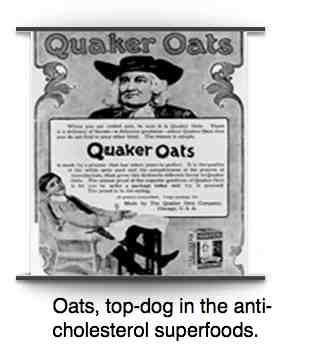
Oats has been used since the Bronze-age, for humans and animals too. Recently it has come to the fore, high in protein and containing more soluble fibre that any other grain. That gives it the proven properties of lowering the toxic LDL cholesterol in the blood, whilst not affecting the friendly HDLs.
Those Quakers knew a thing or two. The history of their oats companies goes back to the Nineteenth-Century in North America.
- Bernard Preston homepage
- Breakfast
- Quaker Oats Recipes
Eaten either cooked as a porridge, or as raw rolled-oats in a muesli, or a meal for baking, it is relatively high in protein for a grain; more than any of the other cereals, and has no gluten.
Interesting research on the so-called "subsequent meal effect" shows that having a whole grain like rolled Quaker oats or legumes at breakfast keeps your blood glucose lower later in the day; but if it is finely ground, refined and precooked then it has little benefit.
Unprocessed rolled oats is one of the most commonly used "resistant" starches; that means that it passes through the small intestine largely undigested, with no surge in blood sugar like potatoes would give, but is instead fermented in the colon to form very beneficial short-chain fatty acids.
Retrogradation is an important principle to grasp; most of the carbohydrate reaches the colon where it does not form glucose. Cooling and then reheating resistant starch makes it even more difficult for the enzymes in the small intestine to digest the sugars. So cook enough rolled oats porridge for two or three days, chill and warm it again tomorrow to make it even less fattening.
But beware of the highly-refined easy oats; they are little different to cake flour.
Scroll down for more about oats and gluten.
Quaker Oats Recipes
Quaker oats recipes means eating a solid breakfast, but without refined carbohydrate; it is what stops the need to snack at 11 o'clock.
Benefits of Quaker oats recipes
That raised protein is one of the reasons why oats fits so neatly into the low glycemic index foods. To lower it still further, add a little fat; perhaps a dab of butter in your porridge.
Butter is back you know.
In case you did not know, low GI means non-fattening; oats has little effect on blood glucose surges and there is no outpouring of insulin to store the sugars as fat.
Oats also has the property of swelling more than other grains in the belly, by absorbing water, and is thus very filling. You can eat less, and still not be hungry.
What is particularly interesting about oats though, is that it also has the greatest amounts of soluble fibre of all the cereals.
It is this soluble fibre that helps prevent cholesterol eaten (say from meat and dairy products) from being absorbed into the blood stream.
Some reports state that a cup of oats a day will reduce your cholesterol by up to 25%; for many that alone means you could go off statins with all their nasty side effects.
That's
massive, and far more effective than the other traditionally known foods
that lower cholesterol like apples, fish and eggplant; legumes and salads too.
Thiamine
Because of our love affair with white rice, there is a nation-wide deficiency of thiamine from our food. A frank deficiency causes beri-beri, a very serious, fatal disease, but today an uncommon condition; however a mild lack causes a multitude of symptoms because of vitamin B1's vital function in many enzymatic processes in the body. One of these maladies, generalised muscle weakness is really not uncommon. (Use that Site Search function)
100g of the rolled whole grain contains about half of your daily requirement of thiamine; a touch more than a cup. But stick to these Quaker oats recipes, because the refined stuff is fattening and nutritionless; most of the goodies have been removed and sent to feed the hogs.
Nutritious food, made fast
This website isn't about making pretty food. It is about nutritious meals that you can throw together in a minimum of time, so that you and your children can go off to school and work with a belly-full of good, sustaining nosh.
Food that you will find tasty and satisfying, that won't leave you starving at 11 o'clock, and will not make you fat. Not unimportant, I think you will agree, and whole grain Quaker oats recipes play an important role.
Make up your own oats muesli
Some mueslis can be dratted expensive, or contain a lot of sugar, but you can make up your own in a jiffy. This one kilogram pack of an inexpensive muesli costs less than one euro in Holland. But it needs to be dickeyed up a bit, so we add our own nuts, seeds and dried fruit like raisins. And of course fresh fruit like blackberries, strawberries, a peach...
Berries are favoured by those on ketogenic eating plans, though I'm not sure why; they still have plenty of fructose, but that is no bother to me in the context of the whole meal, and the benefits of all the phytochemicals in fruit.
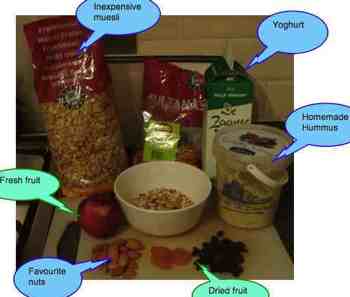
Oats muesli
Once a week I mix up the various different dry ingredients. It takes
less than five minutes. Add your own favourites to the muesli, what's in season, but
never forget it is Quaker Oats recipes.
This is all very complex biochemistry but at the meaning of starch I have tried to simply the science for those who want to understand more about what constitutes beneficial carbohydrate and what is simply junk.
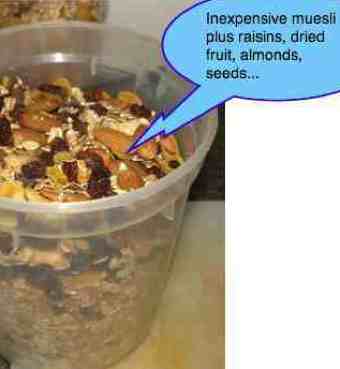
Ferulic acid in oats
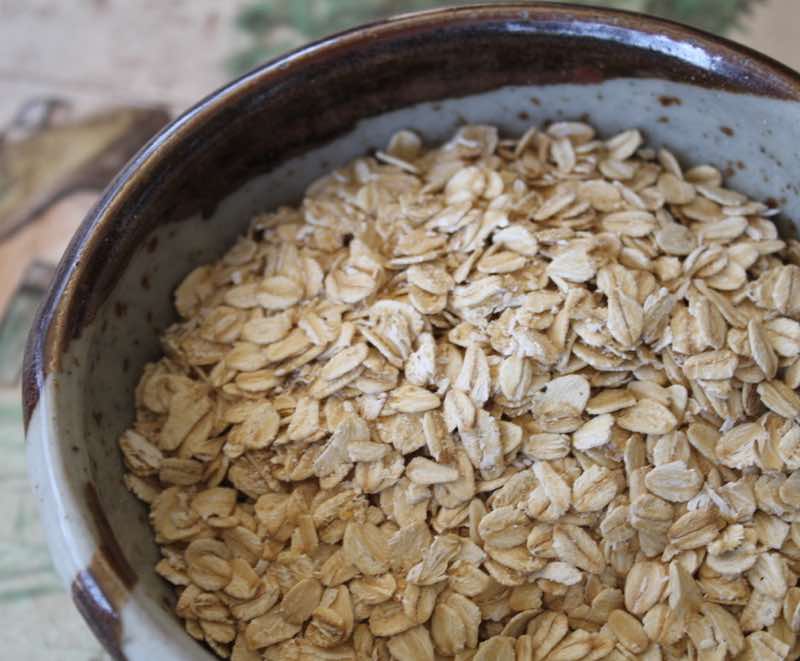
Unrefined oats that still has the bran is known to help regulate the plasma sugar in diabetics, and by relaxing arterioles to lower blood pressure.
It is believed that ferulic acid, a compound found only in the bran, is the active ingredient giving Quaker oats recipes these benefits, and others such as lowering of cholesterol.
This compound, ferulic acid, is found in other whole grains such as wheat and brown rice, and in some legumes, but not in the refined starches, of course.
Quick Hummus Recipe
- Quick hummus can be made in just five minutes.
Breakfast should of course contain a serving of protein, and whilst that in your Quaker oats recipes is relatively high for a cereal, it's not adequate. So what are the options? Meat? Nope, you can only eat meat max once a day. Otherwise the big C. An egg? Yes, that's an option, but how's your cholesterol?
We often enjoy eggs Florentine poached on a bed of spinach.
Cheese? High in fat, but fine if your cholesterol is within the normal range. Fish, yes, that's a good
option, though time consuming unless you have some salmon left over from
last night. In Holland we have a wonderful herring food called rolmops but it is difficult to get elsewhere.
As a DC, I usually work solidly without a break for four hours before lunch; tomorrow it will be seven hours, but that's the exception, and I don't recommend it. Without some protein I'm famished by 11 o'clock. I admit to being odd, but a couple of scoops of this homemade authentic hummus recipe without the garlic sees me home to midday.
Rolled oats, fruit, nuts, seeds, hummus and yoghurt; it makes a wonderful breakfast put together in a jiffy.
Cover your rolled oats muesli with boiling water, and if it gives you indigestion, it does to me, nuke it for one minute; allow to stand for a while so that the rolled oats can absorbe the water.
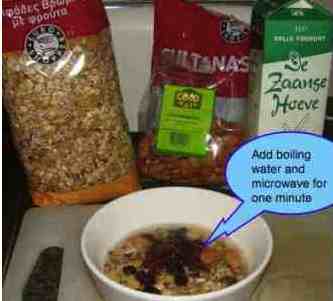
The complete breakfast, carbohydrate, protein, the friendly fats for your brain and nerves, fresh fruit full of antioxidants, yogurt; I promise you, you won't be snacking between meals.
In some folk, raw oats, and even lightly microwaved oats, cause severe indigestion and heartburn. Then you simply have to get the spurtle out and gently simmer your oats for five or ten minutes. Add a teaspoon of raw honey, a little butter and or cream, and you have an equally good meal; only you then have to wash the pot which is a little tedious, but better than a knot in the stomach.
Quaker oats recipes are made using only wholemeal rolled oats; it won't give you a blood sugar rush, but if you are obese, or diabetic, then test your blood an hour after breakfast. Has the glucose risen abnormally?
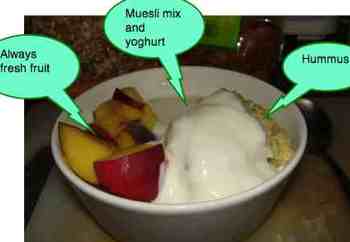
Oats porridge
One of our favourite Quaker oats recipes is simply to turn it into a porridge. Again use only the unrefined rolled grain if you want the nutritional benefits and reduced any surge in blood glucose. As we have gotten older we find it easier on the tum than a raw muesli. Add a teaspoon of raw honey and pat of butter or cream and you have the perfect start to the day. Remember that subsequent meal effect. Satiety is the word; it stays with you for the whole morning.
The good wife likes to add a few slices of fresh fruit or even some dried raisins. You use your own imagination; nuts, seeds and even a teaspoon of tahini?
Start your meals with the liquid
Always start breakfast with a cup of tea, rather than at the end.
Any minute now "she who must be obeyed" is going to be calling for her tea. Why must you start your meals with tea? Indigestion and heartburn is a serious problem for many of us.
(Use the Site Search function for links to items in bold)
There's research now showing the anti-oxidant effect of tea is reduced
by adding milk. Of course, no sugar or chemical sweeteners, but a few
slices of mandarin, or peach, or lemon makes for the perfect weak black refreshment. Add your favourite, I vary it each week, whatever is in season.
Generally, get your vitamins and minerals from your food; sometimes there's a place for a fish oil capsule, for example, if you live far from the sea. I take a B complex occasionally when feeling flat. They are never a substitute for eating properly.
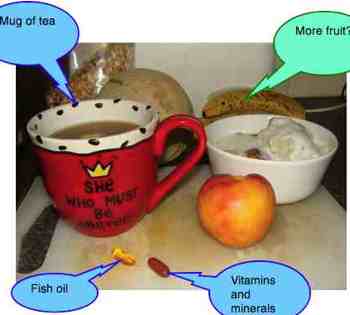
The weekend
And of course, on Sunday morning, a slap breakfast to celebrate the day. Indulge in a fried egg and don't forget the mushrooms. You've earned it by being on the Quaker oats recipe all week! Variation is the spice of life.
You can find our sauteed mushroom by using the search function key.
There are other grains than wheat for pancakes which are always an option if you're needing more Quaker oats recipes; scroll down.
Oats milk
With dairy continuing in disfavour, though I confess I use it with some qualms, oats milk is a not bad alternative; if you make it yourself it is far cheaper and it actually has slightly more calcium. It has a similar sweetness and creamy consistency.
We enjoy an oats milk smoothie too.
Toasting your oats
There are few things I love more than discovering geeks like Lukas Volger[1] who love to tinker with their food as I do. He says that toasting your oats, no matter whether you enjoy it hot in a porridge, or cold as a cereal, improves the flavour many times over.
At this link he gives 28 different ways to enjoy your oats in February. The basic porridge recipe is to saute the oats first in a little butter, and then boil in a mixture of milk and water. If you make enough for a week you can then cool it in the fridge so the starch will retrograde, lowing the glycemic-index.
Some like to brown the butter first before adding the oats; it's such fun to try different things, forcing you to actually taste and smell your food, rather than just swallow it mindlessly whilst watching TV or something other distraction.
So toast your oats in a tad of butter and salt in a heavy bottomed pan for a full five minutes on medium-high, stirring regularly until that wonderful toasted aroma gets the tapeworm stirred up and hungry.
You could of course do this for ten minutes in the oven around 300*F, but it is a waste of electricity, so I don't advocate it, unless going on to bake something else.
Oat meal pancakes
Ingredients
- 2 cups of rolled oats flour
- 3 teaspoons of baking powder
- 1/2 tsp of salt
- 2 eggs
- 1/2 cup of olive oil (or, less)
- 2 cups milk
Let's do it... oat flour pancakes
- Drop a good dollop of butter onto a heavy pan. Medium heat.
- Thoroughly mix together the oats, baking powder and salt.
- Blend the eggs, oil and milk.
- Add the liquid to the dry mix and blend with a hand-blender.
- Add scoops into the hot butter.
Here is a little caution. The more finely ground a grain, the higher the glycemic index; the more fattening it is. You can get away with it, up to a point, because of the added protein and fat; eggs, butter and milk. Keep your oat meal pancakes for special occasions.
Certainly do not add any refined cake flour as some recipes recommend; it will make them smoother, perhaps more palatable, but no longer one of Bernard Preston's nutritious slow foods, made fast. The rolled grain is best.
Oats and Gluten
There is controversy surrounding Quaker oats recipes, and whether it can be eaten by gluten-sensitive people; that is the protein found in wheat, rye and barley.
These grains are usually processed in the same mills, and thus the oats becomes contaminated with traces of gluten; patients suffering from coeliac-disease may be extremely sensitive to even small amounts of this protein.
Newsletter
Our newsletter is entitled "create a cyan zone" at your home, preserving both yourself and Mother Earth for future generations; and the family too, of course. We promise not to spam you with daily emails promoting various products. You may get an occasional nudge to buy one of my books.
Here are the back issues.
- Lifestyle and ideal body weight
- What are ultra-processed foods?
- Investing in long-term health
- Diseases from plastic exposure
- Intensive lifestyle management for obesity has limited value
- A world largely devoid of Parkinson's Disease
- The impact of friendly bacteria in the tum on the prevention of cancer
- There's a hole in the bucket
- Everyone is talking about weight loss drugs
- Pull the sweet tooth
- If you suffer from heartburn plant a susu
- Refined maize meal and stunting
- Should agriculture and industry get priority for water and electricity?
- Nature is calling
- Mill your own flour
- Bake your own sourdough bread
- Microplastics from our water
- Alternative types of water storage
- Wear your clothes out
- Comfort foods
- Create a bee-friendly environment
- Go to bed slightly hungry
- Keep bees
- Blue zone folk are religious
- Reduce plastic waste
- Family is important
- What can go in compost?
- Grow broad beans for longevity
- Harvest and store sunshine
- Blue zone exercise
- Harvest and store your rainwater
- Create a cyan zone at your home
Is oats gluten free? Yes, but it has the highest proportion of protein of all the cereals; around 20 percent.
It would seem that a few coeliac patients are still sensitive to some of the amino acids in oats. Generally, it is allowed for these persons, if it is pure and uncontaminated by other grains; that is extremely difficult to guarantee.
Do you suffer from chronic diarrhoea? Try cutting out all these grains from your meals for a month. You may be surprised; talk to a nutritionist for details of gluten-free food. Personally, having had such success with kefir benefits, I would rather try that first to normalise the friendly flora in the gastrointestinal tract.
One good alternative is the use of sourdough. The long exposure to lactobacillus breaks down the offending amino acid chains; proline is the spoke in the wheel.
You might even try this sourdough bread recipe.
Read more about the meaning of gluten and how you could quite likely still enjoy your loaf of bread.
Sourdough oats
This has me thinking; could one make a sourdough starter with oats instead of wheat or rye and add it to the grain to ferment before cooking? I am going to try it.
When browsing use right click and Open Link in New Tab, or you may get a bad gateway signal.
Did you find this page interesting? How about forwarding it to a friendly book or food junkie? Better still, a social media tick would help.
- Bernard Preston homepage
- Breakfast
- Quaker Oats Recipes
Address:
56 Groenekloof Rd,
Hilton, KZN
South Africa
Website:
https://www.bernard-preston.com